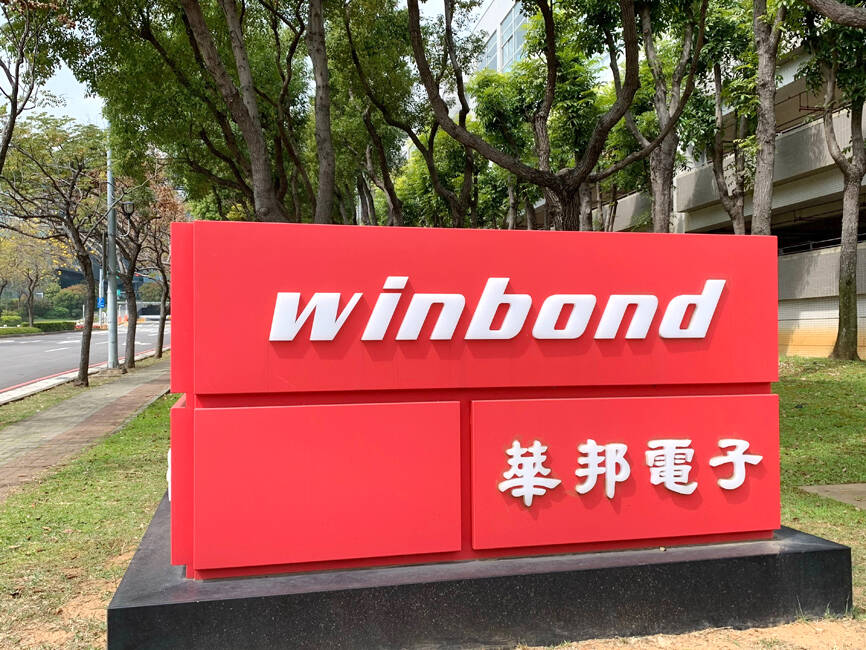Winbond Electronics Corp (華邦電) yesterday gave an upbeat outlook for next year as strong demand for less-advanced memory chips has helped it swing into profit in five quarters, with the upcycle to persist longer than previous ones.
The firm is benefiting from a structural adjustment in memory manufacturing technology transition as the world’s top three players are allocating more capacity for high-bandwidth memory or DDR5 chips to support booming artificial intelligence (AI) demand while reducing supply of less-advanced DDR4 chips, Winbond said.
The transition has led to supply constraints of DDR4 chips and higher chip prices, along with demand for greater memory capacity to support increasingly complicated devices, including AI servers, PCs, robot vacuums, drones and wireless earbuds, the company said.

Photo: Grace Hung, Taipei Times
“We expect such a structural transition will last for a period of time. It could take one to two years,” Winbond president James Chen (陳沛銘) told an online investors’ conference. “A growing number of customers are approaching us to negotiate for long-term supply agreements. Such strong demand will not diminish overnight. Demand for 2026 is very healthy.”
In the past, a DRAM upcycle usually lasted for six to nine months before dipping into a downcycle, Chen said.
This time, the upturn would not end in just a six-to-nine-month period, as some customers have requested six-year supply agreements, he said.
Winbond expects chip prices to climb this quarter at a faster pace than the third quarter, attributed to limited capacity and demand for higher-density chips, Chen said.
He also expects significant growth in revenue and chip shipments this quarter compared with the previous quarter.
The memory industry is returning to the “right track,” Chen said.
The company’s DRAM prices rose more than 10 percent quarter-on-quarter, outgrowing flash memory chips. Shipments of DRAM and flash memory chips both increased by a single-digit percentage sequentially.
Winbond plans to invest about NT$40 billion (US$1.29 billion) to increase capacity for DRAM and flash memory by 60 percent and 20 percent respectively.
In the third quarter, the company posted a net profit of NT$2.94 billion, snapping a losing streak over the previous four quarters. The company lost NT$1.31 billion in the second quarter and NT$9 million in the third quarter last year.
Gross margin soared to 46.7 percent, from 22.7 percent in the second quarter and 29.3 percent a year earlier.
For the company’s memory business, gross margin surged to 51 percent from 12 percent in the previous quarter and 21 percent a year earlier. Winbond attributed the significant improvement to reversal of a previous chip inventory write-down.
The gross margin of its memory business is expected to be mostly unchanged this quarter, driven by higher chip prices and shipments, Chen said.
DRAM and flash memory accounted for 65 percent of the company’s total revenue last quarter, while logic chips contributed 30 percent.

RUN IT BACK: A succesful first project working with hyperscalers to design chips encouraged MediaTek to start a second project, aiming to hit stride in 2028 MediaTek Inc (聯發科), the world’s biggest smartphone chip supplier, yesterday said it is engaging a second hyperscaler to help design artificial intelligence (AI) accelerators used in data centers following a similar project expected to generate revenue streams soon. The first AI accelerator project is to bring in US$1 billion revenue next year and several billion US dollars more in 2027, MediaTek chief executive officer Rick Tsai (蔡力行) told a virtual investor conference yesterday. The second AI accelerator project is expected to contribute to revenue beginning in 2028, Tsai said. MediaTek yesterday raised its revenue forecast for the global AI accelerator used

TEMPORARY TRUCE: China has made concessions to ease rare earth trade controls, among others, while Washington holds fire on a 100% tariff on all Chinese goods China is effectively suspending implementation of additional export controls on rare earth metals and terminating investigations targeting US companies in the semiconductor supply chain, the White House announced. The White House on Saturday issued a fact sheet outlining some details of the trade pact agreed to earlier in the week by US President Donald Trump and Chinese President Xi Jinping (習近平) that aimed to ease tensions between the world’s two largest economies. Under the deal, China is to issue general licenses valid for exports of rare earths, gallium, germanium, antimony and graphite “for the benefit of US end users and their suppliers

Dutch chipmaker Nexperia BV’s China unit yesterday said that it had established sufficient inventories of finished goods and works-in-progress, and that its supply chain remained secure and stable after its parent halted wafer supplies. The Dutch company suspended supplies of wafers to its Chinese assembly plant a week ago, calling it “a direct consequence of the local management’s recent failure to comply with the agreed contractual payment terms,” Reuters reported on Friday last week. Its China unit called Nexperia’s suspension “unilateral” and “extremely irresponsible,” adding that the Dutch parent’s claim about contractual payment was “misleading and highly deceptive,” according to a statement

Artificial intelligence (AI) giant Nvidia Corp’s most advanced chips would be reserved for US companies and kept out of China and other countries, US President Donald Trump said. During an interview that aired on Sunday on CBS’ 60 Minutes program and in comments to reporters aboard Air Force One, Trump said only US customers should have access to the top-end Blackwell chips offered by Nvidia, the world’s most valuable company by market capitalization. “The most advanced, we will not let anybody have them other than the United States,” he told CBS, echoing remarks made earlier to reporters as he returned to Washington